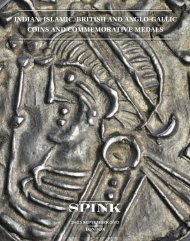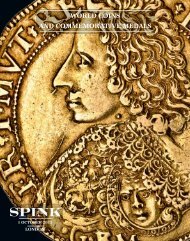bentley priory - Spink
bentley priory - Spink
bentley priory - Spink
You also want an ePaper? Increase the reach of your titles
YUMPU automatically turns print PDFs into web optimized ePapers that Google loves.
THE BENTLEY PRIORY BATTLE OF BRITAIN TRUST APPEAL CHARITY AUCTION<br />
after the undercarriage retracted the Earth vanished, and they<br />
were cocooned in white vapour. It was an eerie feeling, as if<br />
they were hanging motionless in a ghostly void, with only the<br />
needles of the instruments to tell them what was happening.<br />
Within minutes Starlight had vectored them on to a bandit,<br />
and soon between layers of cloud John had a Heinkel in sight<br />
1,000 yards ahead.<br />
This was no sitting duck. Suddenly, the Heinkel whipped<br />
over into a steep left turn, enabling the gunners to fire a<br />
broadside as they flashed past about a hundred yards away on<br />
the Beaufighter’s beam. In a flash, John pulled round in a<br />
violent turn which put heavy ‘g’ on Jimmy, ramming him<br />
down hard into his seat. John instinctively knew that this<br />
German pilot knew his stuff, and his crew likewise.<br />
The Heinkel had already disappeared into the mist and<br />
Jimmy, dazzled by the glare outside, could not decipher<br />
anything on his radar displays. Almost a minute had gone by,<br />
and he had lost contact. John called Starlight for help. They<br />
had tracked the bandit flying north, near Shaftesbury. Jimmy<br />
was annoyed at his failure to maintain contact, and resolutely<br />
kept his head down, concentrating on his AI set.<br />
Starlight produced more vectors, and the chase continued.<br />
Suddenly John saw the Heinkel again, and closed in on him<br />
with ruthless determination. Jimmy, realising that this was<br />
going to be a duel between champions, put on his sunglasses,<br />
which he carried for daytime practice, so that he could see<br />
what was going on. He was just in time to see the Heinkel<br />
whip past, heeling over at a staggering angle, with the<br />
gunners blazing away off-target. John was saving his<br />
ammunition in his usual fashion until he was within lethal<br />
range.<br />
Jimmy turned back to his set, and now, when he removed his<br />
glasses, the blip showed up clearly. The Heinkel pilot<br />
straightened up, apparently thinking that he had thrown off<br />
his pursuers. He must have been amazed and shocked when<br />
John re-appeared behind him yet again a few minutes later.<br />
But he did not panic, and again turned to the attack, a sound<br />
tactic. The Heinkel’s engines were clearly at full power. This<br />
time John held his turn inside the bandit, determined not to<br />
give an inch. The turns became tighter and tighter, until the<br />
Heinkel seemed to be upside-down over their heads. The ‘g’<br />
forces were becoming intolerable, and the tactics were<br />
becoming a ‘winding match’, John’s term for two aircraft<br />
trying repeatedly to out-turn each other. Eyeballs drag in<br />
their sockets, and neck muscles ache with the effort it takes to<br />
look at dials and instruments. Breathing becomes laboured,<br />
proving that the aircraft can take more ‘g’ than the crew.<br />
Relentlessly, John continued to haul the Beaufighter round<br />
the sky.<br />
Finding that he could not out-turn the Beaufighter, the<br />
Heinkel dropped the thwarted tactic, and resorted to twisting<br />
and diving... He would disappear under John’s wing, and<br />
then re-appear on the opposite track, flashing past at<br />
impossible angles.<br />
The contest had developed into a death-or-glory duel<br />
between two absolute masters of their machines. The entire<br />
fuselage of the Beaufighter vibrated, the sleeve-valve engines<br />
no longer making a soft booming sound but howling as<br />
airspeed built up. The needles of the altimeter raced<br />
backwards around the dial, while the blind-flying panel had<br />
gone crazy and the artificial horizon had gone haywire and<br />
‘thrown in the sponge.’<br />
John muttered, ‘Hm... this isn’t good enough’ very quietly,<br />
talking half to himself. Calmly, he looked at the instruments<br />
interpreting the message they were trying to tell him. ‘Now...<br />
let me see... left bank... that’s better.’ Jimmy suddenly saw<br />
the Heinkel again as it flashed past apparently heading<br />
straight downwards. A quick glance at the AI set told him<br />
that they were frighteningly close to high ground, which rose<br />
up to 900 feet. As he watched the blip from the Heinkel it<br />
disappeared in the foliage of ground returns. Starlight could<br />
do nothing, and the blip had vanished from their own<br />
cathode-ray tube.<br />
Jimmy, exhausted, searched for a homing beacon on the AI<br />
set. John who could resist feeling exhausted, felt his way<br />
gently down through the clouds... It was a relief to get back<br />
to Middle Wallop after two-and-a half hours of highly<br />
charged flying. When they broke off the engagement, John<br />
had the Beaufighter at over 340mph indicated, which was<br />
very high in these blind low-level conditions with a toppled<br />
horizon.<br />
News soon came through that the Heinkel had ‘gone in’ on<br />
the high ground of the sodden slopes of Cranborne Chase.<br />
Apparently it had broken out of cloud cover at a few hundred<br />
feet, diving almost vertically, and failed by only a few feet to<br />
pull out in time. They found the wreckage close to the lonely<br />
village of Alvediston. Intelligence later discovered that the<br />
pilot had been Hauptmann Siegfried Langer, the<br />
Commanding Officer of 7 Staffel of KGr. 100. Throughout<br />
the battle John had not fired a single shot, so the encounter<br />
was truly a match between champions.’ (ibid)<br />
Definitely Time For A Rest<br />
A few weeks later Cunningham was told that he was due a<br />
‘rest’, he had been on operational flying for the best part of<br />
three years straight; usually a rest posting was given after 18<br />
months to 2 years in Fighter Command; Cunningham was to<br />
be posted to Headquarters, No. 81 Group - the training<br />
group of Fighter Command; just before leaving Middle<br />
Wallop he received a Bar to his D.S.O.; Cunningham was to<br />
be tasked with directing the work of all the night-flying<br />
OTUs; he decided that this was a job which required<br />
assistance, and as a consequence managed to pull a few<br />
strings to get Rawnsley posted with him; neither enjoyed<br />
their new desk job, and it was decided that it would be better<br />
to tour the various OTUs and have personal contact with the<br />
pupils and the instructors, ‘the only practical way of visiting<br />
them was by air. Initially they used the Group’s Oxford, but<br />
then John arranged with 604 Squadron to have his beloved<br />
Beaufighter on loan.<br />
Then they felt happy and free, flying above the weather and<br />
making their way from one radar beacon to another as they<br />
traversed the country to visit the OTUs. Instructors and<br />
pupils alike watched with awe John’s faultless touchdowns<br />
and short landing runs, and listened with even greater respect<br />
to his suggestions and advice.’ (ibid)<br />
85 Squadron - Mosquitos At Last<br />
Thankfully for both Cunningham and Rawnsley their brief<br />
sojourn with paperwork was only to last six months; in<br />
January 1943 Cunningham was given the command of 85<br />
Squadron, and Rawnsley was to go with him as the<br />
squadron’s Navigator Leader; Cunningham arrived at<br />
Hunsdon to find the squadron in need of a shake up; several<br />
of the existing crews were due for a rest and through his<br />
connections Cunningham managed to get some of the crews<br />
that he had worked with in 604 Squadron to transfer in;<br />
things started to look up when the Squadron was equipped<br />
with the improved AI Mk VIII in March 1943, and with the<br />
move to West Malling, Kent, in May, ‘This was a plum<br />
posting, because the Squadron would be defending the<br />
famous Biggin Hill sector, and there was plenty of trade<br />
coming in from the short and direct route on the southeastern<br />
approach to London from the Channel ports.’ (ibid)<br />
The Luftwaffe started to employ the Focke-Wulf 190, a new<br />
and very fast fighter-bomber, ‘these aircraft began carrying<br />
out hit-and-run raids by both day and night.... Having a small<br />
wingspan, the 190 was difficult to locate, and, particularly<br />
once it had dropped its wing tanks and large bomb which was<br />
carried under its belly, it was very difficult to catch. It had the<br />
advantages of speed, size and manoeuvrability, and a sudden<br />
dash across the narrow Strait of Dover was going to make it<br />
an extremely hard target. The modus operandi of night<br />
interception had been based on kills by stealth, but it would<br />
need great skill and luck to knock down 190s that way.’ (ibid)<br />
WWW.SPINK.COM

















